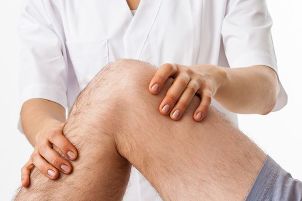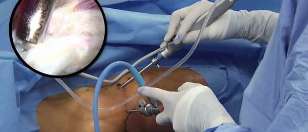What does the diagnosis "osteoarthritis of the knee joint"
This is a disease in which the cartilage of the deformed and decomposed. Cartilage, wherein the dense tissue, plays the role of shock absorbers in each joint, it is necessary for its operation. When the breakdown of cartilage in the joint gradually loses mobility, and if the disease is left untreated, then completely stops working. However, in the early stages of osteoarthritis of the perfectly curable with medication and physiotherapy.

By the way, About 12% of young people suffer from arthritis, and in the retirement age, this number is higher by a half — quarter of all older complain of symptoms of this disease.
Women suffer from joint arthritis suffer more often men.
The risk group also includes athletes — active exercise, and microtrauma of the cartilage often lead to limitation of motion of the joint at a young age.
There is evidence that for osteoarthritis there is a certain genetic predisposition. If you are in the family there were cases of this disease, you should closely monitor the condition of the joints.
The causes of the disease
The causes of the development of arthrosis of the knee joint are many. These include:
- injury and microtrauma of the joints;
- overweight — it is another burden on the knee joint;
- metabolic disorders in which cartilage tissue is experiencing a lack of essential nutrients;
- unbalanced load during physical work or too intense exercise;
- failure of the circulatory system, in which disturbed nutrition of the cartilage;
- relentless spasms of blood vessels of the legs. The degree of arthrosis of the knee joint and the symptoms
Osteoarthritis of the knee joint develops gradually.We therefore distinguish several degrees of this disease.
1 degree. At this stage the changes are even smaller and can even freely determined in the instrumental links to the surveys. To developing osteoarthritis show symptoms like minor joint stiffness after long immobility (often — in the morning) and crunching in the joint when sudden movements. More pronounced pain usually there is no reason why people often ignore these symptoms and go to doctors only when there is arthrosis of the knee joint reaches 2. stage.
2 the degree of the Joint is deformed, the x-ray images apparent joint space narrowing and deformation of the cartilage. Symptoms are significant — patients complain of constant pain, which intensifies at the beginning of the movement, limitation of motion, significant stiffness in the morning hours. A small effort (e.g. lifting a load) can also cause pain. Sometimes the skin over the joint is red, a little larger and still warm to the touch — it says about the development of the inflammatory process. When osteoarthritis of the knee joint grade 2-nd ill note the strengthening of pain during change of weather or after hypothermia.
3 the degree. Severe osteoarthritis of the knee joint is characterized by severe pain on all movements, lameness, sometimes noticeable shortening of the limb. The area of the joint strongly enlarged, and in the morning a person just can't get out of bed — sometimes have to wait half an hour, than the mobility of the partially recovers. In 3. the degree of arthrosis of the knee joint cartilage is much thinner, and something where it is destroyed completely, so the bones do not touch each other.
4 the degree. The complete destruction of the cartilage, excruciating pain and immobility — it is what you can get, is to ignore the symptoms of osteoarthritis up to the last. The articular slit disappears and it starts the deformation of the bones. The diagnosis in the first stage of treatment
When suspicion of the disease, you should immediately make an appointment with a doctor a podiatrist, who will put the diagnosis.
Diagnosis of osteoarthritis involves laboratory and instrumental methods.
To the first belongs the general and biochemical analysis of blood and urine. These tests allow to exclude an autoimmune disease, which led to the defeat of the joints, determine the presence of inflammation.
From the instrumental methods of diagnosis of arthritis is the most commonly used simple radiography in two planes, ULTRASOUND, computed tomography, magnetic resonance imaging.
Methods of treatment of arthrosis of the knee joint
Osteoarthritis of the knee joint being treated, but the prognosis will be the most advantageous, if you start therapy as soon as possible, 1-2-th stage of the disease. Methods of treatment are many, but only a comprehensive treatment gives the desired result.
Among the effective methods — shock waves, drug therapy, traction of the joints, intra-articular introduction of drugs, muscle toning and therapeutic physical education (LTV).
Drug therapy
Helps to fight not only with the symptoms of the disease.
Non-steroidal anti-antiinflammatory drugs
reduce inflammation and pain.
chondroprotectors
stimulate the nutrition of the articular cartilage. As a supplement are widely used ointments and gels with painkillers effect, and also external resources for the alleviation of inflammation and improve microcirculation of the blood.
Durable goat
Shock-wave therapy — a method by which a therapeutic effect is achieved due to the influence of sound waves on the changed tissue of the joint. This is a relatively painless procedure, which however allows to achieve excellent results — remove the pain, destroy and soften the calcium deposits (osteophytes), improve the metabolic processes in the tissues, result in normal blood circulation and relieve swelling, speaking the language of ordinary people — "clean up" the joint. The effectiveness of treatment reaches up to 90%.
Physical therapy
Therapeutic physical education — virtually a necessary part of the therapy of arthrosis of the knee joint. kinesitherapy — this is a special exercise with carefully counted the load, and mechanotherapy — exercise, carried out with the help of special medical instruments. Movement therapy allows you to undo the connections between mobility, improve its blood supply, to create and strengthen the ligamentous apparatus.
Traction in the joints
Traction, or traction of the joints, is carried out on a special orthopedic device. This method is the flexing of the joint and extends the joint slit, in consequence, reduces the friction of the joint surfaces and sick joint unloading. The positive effect noted in 80% of cases.
Intra-articular injections
This is carried out for the sump and a large amount of synovial fluid, and for the administration of drugs — anti-inflammatory, painkillers and increases blood supply to the articular cartilage, medications, etc.
It is worth to say about this method, as is the injection of your own plasma of the patient in the common bag — of growth factors, which are contained in the plasma. They accelerate the recovery and regeneration of damaged articular cartilage. The advantage of plazmolifting lies in the fact that on its own the plasma happens, there is no allergy, it is a safe biological stimulator of regeneration. In 2-3 months after the course plazmolifting patients note that the pain and stiffness has decreased to half, and the mobility of the joint is improved.
Muscle toning
Methods of treatment based on stimulation of the muscles of the microcurrents. When osteoarthritis of the knee joint occurs atrophy of the muscles of the thigh, disrupting their blood supply. This greatly increases the load on the joints.
Muscle toning allows you to strengthen the muscles, and thus remove the load from the joint, improve blood circulation, create a reliable framework for the joint.
Surgery

arthroscopic debridment. Methods aimed at the removal of the joint elements of the destroyed cartilage parts of the meniscus. The operation is performed under the control of the video camera. Joint. If the joint is destroyed completely, then it can only replace the artificial. The endoprosthesis is resorted to only in the most serious cases — on the third or fourth stage of the disease.
The new joint will last up to 12-15 years. For the early diagnosis of arthrosis of the knee joint it is important to pull up to the last, and not postpone visit to the doctor, doing self-heal and application of the OTC remedies.
Osteoarthritis develops gradually, but in some people it is among the first symptoms of the disease and the time when the joint can only save operation, passing only a few years — it all depends on the individual characteristics of the organism. In most cases, early diagnosis and comprehensive approach to the treatment able to stop the symptoms of arthritis and restore joint.













































